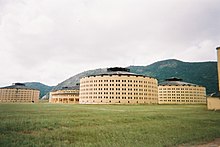Presidio Modelo

The Presidio Modelo was a "model prison" with panopticon design, built on the Isla de Pinos ("Isle of Pines"), now the Isla de la Juventud ("Isle of Youth"), in Cuba. It is located in the suburban quarter of Chacón, Nueva Gerona.
History[]

The prison was built under the President-turned-dictator Gerardo Machado between 1926 and 1928.[1] The five circular blocks, with cells constructed in tiers around central observation posts, were built with the capacity to house up to 2,500 prisoners. The panopticon design allowed the guards to watch the prisoners constantly.
Most of the survivors of the rebel attacks on Moncada Barracks in July 1953 – including Fidel Castro and his brother, Raul Castro – were imprisoned there, most of them until 1955. At that time, the four circular buildings were packed with 6,000 men, every floor was filled with trash, there was no running water, food rations were meagre, and the government supplied only the bare necessities of life.[2] However, Castro and the other rebels were not kept in the circular buildings with their small cells and harsh conditions, but were instead kept in the hospital wing, which had a larger living area with better beds and living conditions, what some people have referred to as "luxury conditions".[citation needed]
The dictator Fulgencio Batista had made the mistake of placing all the conspirators together in the hospital wing, and they proceeded to treat it as a revolutionary boot camp, congregating for daily lessons on politics and conducting secret communications with supporters around Cuba. "What a fantastic school this prison is!" Castro wrote in a letter. "From here I’m able to finish forging my vision of the world...".[3]
After Castro's revolutionary triumph in 1959, Presidio Modelo remained in operation. By 1961, due to the overcrowded conditions (up to 4000 prisoners at one time), it was the site of various riots and hunger strikes, especially just before the Bay of Pigs invasion, when orders were given to line the tunnels underneath the entire prison with several tons of TNT.[4]
Prominent Cuban political prisoners such as Armando Valladares,[citation needed] ,[5] and Pedro Luis Boitel[6] were held there at one point or another during their respective incarcerations. It was permanently closed by the government in 1967.[1]
The prison now serves as a museum and has been declared a national monument. The old administration building now serves as a school and research center.
See also[]
References[]
- ^ Jump up to: a b "Presidio Modelo in Cuba and the panopticon idea « dpr-barcelona". Dprbcn.wordpress.com. April 18, 2012. Retrieved November 6, 2012.
- ^ Wallace, Robert; Melton, H. Keith; Schlesinger, Henry R. (2008). Spycraft: The Secret History of the CIA's Spytechs, from Communism to Al-Qaeda. Penguin. pp. 258–259. ISBN 9781440635304.
- ^ "Cuba Solidarity Campaign : Cuba Si : Presidio Modelo, School of Revolutionaries". Cuba-solidarity.org.uk. Archived from the original on November 4, 2012. Retrieved November 6, 2012.
- ^ "Testimonios - Colchones de dinamita y TNT para prisioneros" (in Spanish). Archived from the original on June 16, 2011. Retrieved November 21, 2010.
- ^ "Emilio Ichikawa » Roberto Martín Pérez: "He hecho un libro polémico"". Eichikawa.com. November 2, 2012. Archived from the original on March 11, 2012. Retrieved November 6, 2012.
- ^ "Pedro Luis Boitel and the Future of Freedom in Cuba | National Endowment for Democracy". Ned.org. Retrieved November 6, 2012.
External links[]
| Wikimedia Commons has media related to Presidio Modelo. |
- Presidio Modelo (Isla de la Juventud) at EcuRed (in Spanish)
Coordinates: 21°52′40″N 82°45′59″W / 21.87778°N 82.76639°W
- Buildings and structures in Isla de la Juventud
- Defunct prisons in Cuba
- Museums in Cuba
- Nueva Gerona
- Prison museums in North America
- Tourist attractions in Isla de la Juventud
